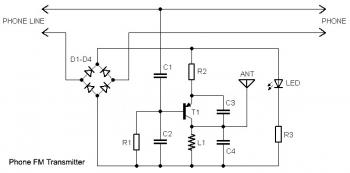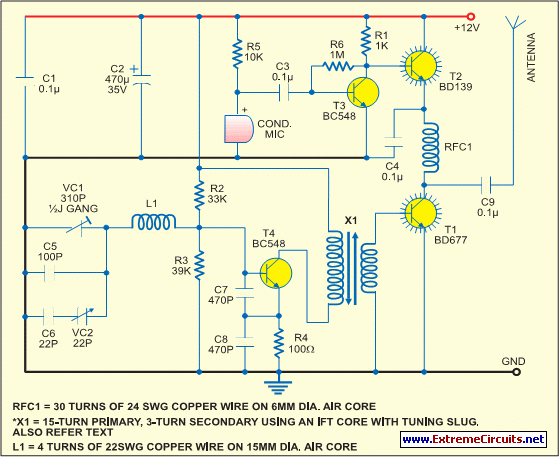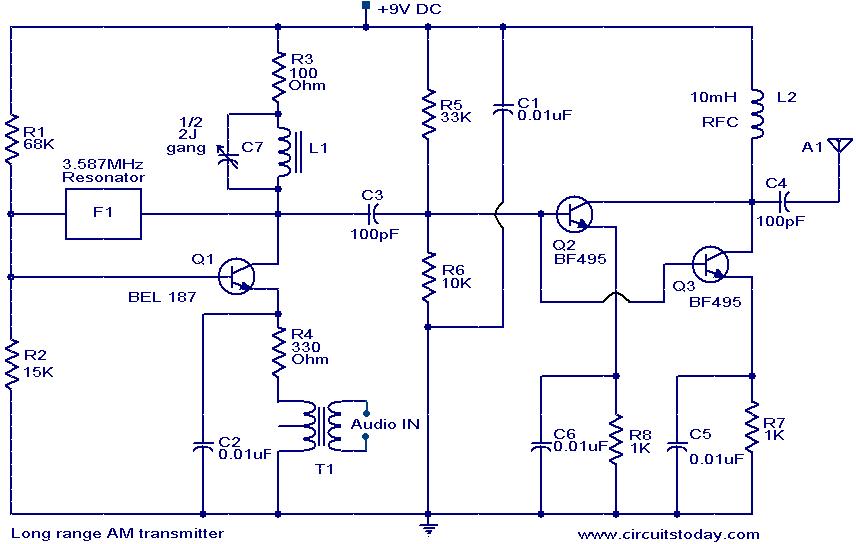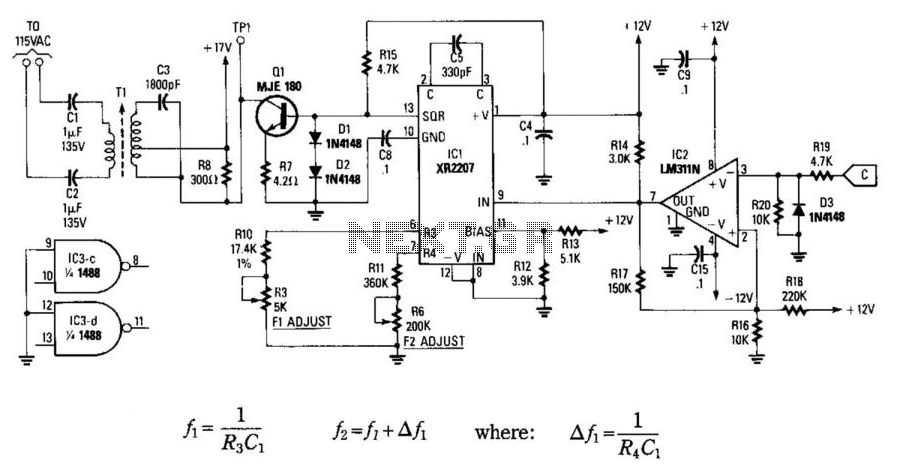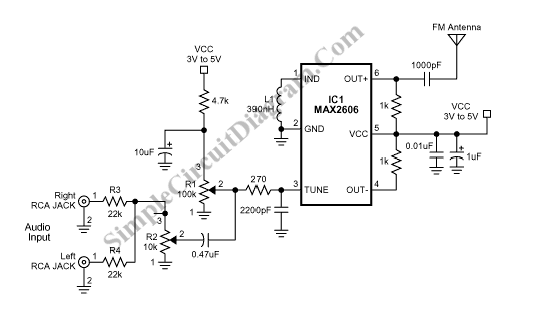
SAA1057 PLL Synthesized FM Transmitter
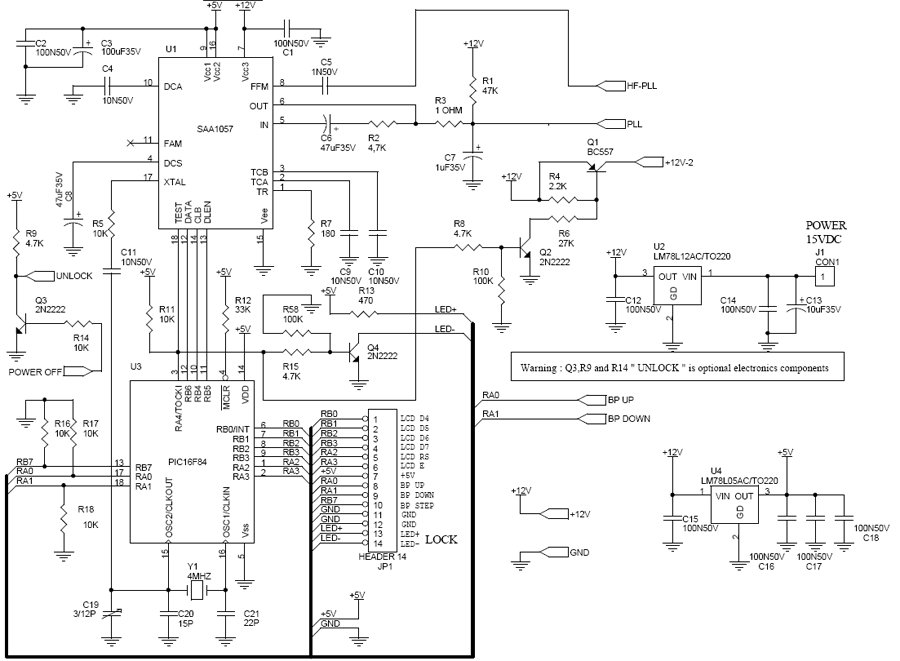
The operation of the circuit is managed by a microcontroller from MICROCHIP, specifically the PIC16F84. This microcontroller supports buttons and a 2-line, 16-character LCD display, along with the PLL circuit SAA1057. The voltage-controlled oscillator (VCO) is implemented using transistor Q8, which is paired with two varactor diodes, BB109. Additionally, a buffer transistor Q7 separates the VHF signal obtained in two paths, one of which is directed to transistor Q9.
The circuit utilizes the MICROCHIP PIC16F84 microcontroller, which serves as the central processing unit, managing inputs from buttons and controlling the output to a 2-line, 16-character LCD display. The microcontroller is programmed to handle user interactions and display relevant information on the LCD, facilitating user-friendly operation.
The PLL circuit, SAA1057, is integrated into the design to provide frequency synthesis and demodulation capabilities. This allows the system to lock onto specific frequencies, enhancing signal stability and quality. The VCO, implemented with transistor Q8, is a critical component that generates the necessary oscillation for the PLL operation. The inclusion of two BB109 varactor diodes allows for voltage-controlled tuning, enabling the VCO to adjust its frequency in response to varying control voltages.
Transistor Q7 functions as a buffer, effectively isolating the VHF signal to prevent loading effects that could degrade signal integrity. This buffering is crucial for maintaining the performance of the circuit, as it ensures that the VHF signal is split appropriately for further processing. One branch of the signal is directed towards transistor Q9, which may be responsible for amplification or further signal processing, depending on the overall design requirements.
In summary, the described circuit combines a microcontroller, a PLL, a VCO, and various transistors to create a robust system capable of handling VHF signals while providing user interaction through buttons and an LCD display. The careful selection of components and their configurations ensures that the circuit operates efficiently and reliably in its intended application.The functioning of all is provided by a microcontroller from MICROCHIP PIC16F84 which provides support for buttons, LCD 2 lines of 16 characters and the circuit pll SAA1057. The VCO is entrusted to the transistor Q8 associate of his two diodes varicaps BB109, a floor buffer Q7 separates the VHF signal obtained in two ways, on the one hand to Q9 to ensl..
🔗 External reference
The circuit utilizes the MICROCHIP PIC16F84 microcontroller, which serves as the central processing unit, managing inputs from buttons and controlling the output to a 2-line, 16-character LCD display. The microcontroller is programmed to handle user interactions and display relevant information on the LCD, facilitating user-friendly operation.
The PLL circuit, SAA1057, is integrated into the design to provide frequency synthesis and demodulation capabilities. This allows the system to lock onto specific frequencies, enhancing signal stability and quality. The VCO, implemented with transistor Q8, is a critical component that generates the necessary oscillation for the PLL operation. The inclusion of two BB109 varactor diodes allows for voltage-controlled tuning, enabling the VCO to adjust its frequency in response to varying control voltages.
Transistor Q7 functions as a buffer, effectively isolating the VHF signal to prevent loading effects that could degrade signal integrity. This buffering is crucial for maintaining the performance of the circuit, as it ensures that the VHF signal is split appropriately for further processing. One branch of the signal is directed towards transistor Q9, which may be responsible for amplification or further signal processing, depending on the overall design requirements.
In summary, the described circuit combines a microcontroller, a PLL, a VCO, and various transistors to create a robust system capable of handling VHF signals while providing user interaction through buttons and an LCD display. The careful selection of components and their configurations ensures that the circuit operates efficiently and reliably in its intended application.The functioning of all is provided by a microcontroller from MICROCHIP PIC16F84 which provides support for buttons, LCD 2 lines of 16 characters and the circuit pll SAA1057. The VCO is entrusted to the transistor Q8 associate of his two diodes varicaps BB109, a floor buffer Q7 separates the VHF signal obtained in two ways, on the one hand to Q9 to ensl..
🔗 External reference
